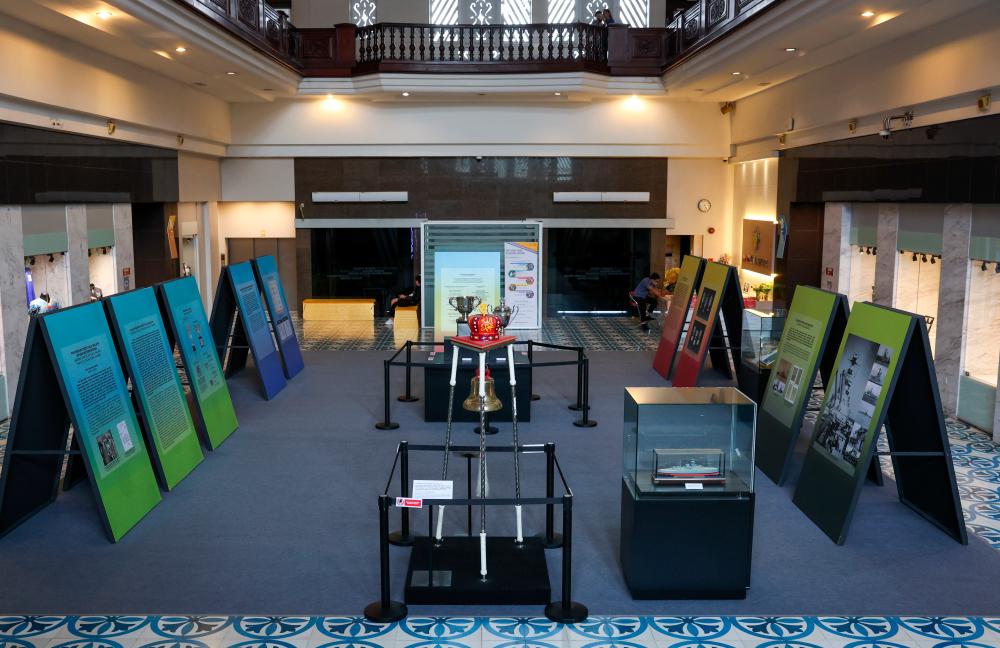KUALA LUMPUR: The two HMS Malaya trophies produced in London in 1921 that are symbolic of the history of football and rugby in the country, can be seen up close at the ongoing 100 Years Trophy of HMS Malaya Exhibition at National Museum until Jan 31.
Muhammad Faiz Azizan, the curator of the Conservation Centre of the Department of Museums, said the National Museum was responsible for looking after the trophies and ensuring the trophies are well preserved.
He said that, among others, various studies and conservation measures had been carried out in collaboration with the Malaysian Nuclear Agency (ANM) in determining the authenticity, damage and originality of the material as well as evaluating the structure of the trophies.
He added that the conservation process was divided into two, namely preventive and curative, covering aspects of temperature, relative humidity and deterioration agents, which are carried out as scheduled to ensure the collection is in a condition conducive for display.
“The silver metal-based artefacts often encounter corrosion that will produce a grey oxidised layer on their surface known as tarnish.
“As such, the curative conservation of the silver metal can be divided into three stages, namely cleaning, polishing and protection of the trophies,” he told Bernama.
Muhammad Faiz said nuclear techniques such as X-Ray Fluorescence (XRF), Fast Gamma Ray Neutron Activation (PNSGP), neutron imaging, radiography and Eddy Current methods are used to determine the authenticity of the material and evaluate the structural strength of the trophy.
“Material characterisation studies such as XRF and Eddy Current have proven that the materials of the two HMS Malaya trophies are original and made of silver and Argentium alloys while imaging studies like radiography and neutron imaging give a true picture of the grafting methods used for the trophies,” he said.
In revealing the history of the artefacts, he said both trophies were obtained after the maiden visit of a British armoured warship named Her Majesty’s Ship (HMS) Malaya, in honour of the Federated Malay States in Malaya, which financed the construction of the ship that docked at Port Swettenham (now Port Klang) in 1921.
“As a token of appreciation, the then Commander of HMS Malaya, Captain HT Buller donated the two HMS Malaya trophies to the Federated Malay States for football and rugby competitions,” he said.
He said the prestigious trophies were used for about 46 years for football and 65 for rugby before being replaced by the Malaysia Cup and the Agong’s Cup respectively.
Muhammad Faiz said that Malaysia’s first Prime Minister, Tunku Abdul Rahman Putra Al-Haj, who was also the then Football Association of Malaya (FAM) president, handed over the 73.7-centimetre (cm) tall HMS Malaya trophy for football to the then National Museum director, Datuk Sharum Yub on Feb 19, 1968.
The HMS Malaya trophy for rugby, which was 57.8cm tall, was handed over to the National Museum by the founder of the Malaysian Rugby Union (MRU; now known as Malaysia Rugby), Sultan Haji Ahmad Shah on Aug 9, 1986.
Regarding the exhibition, Muhammad Faiz said it has received a very encouraging response and that, so far, 81,338 people had visited it since it was opened on Nov 1 last year.
“The excellence of this trophy is translated through this exhibition to the community so that the historical value of these two trophies can be seen and appreciated by everyone because, through sports, Malaysians of various ethnicities, races and religions can be united,” he said, adding that the HMS Malaya trophy for football was taken to the National Stadium in Bukit Jalil in conjunction with the Malaysia Cup final on Nov 31, 2021.
The exhibition also features collectors’ items like the ticket for the HMS Malaya Cup final in 1953 and the first logo of the Singapore Amateur Football Association in 1929.
Also on display are the first logo of the Football Association of Malaya of 1939 and the Football Association of Malaya Rule Book as well as a collection of players’ jerseys, including that which the late Mokhtar Dahari wore at the 1973 Southeast Asian Peninsular (SEAP) Games. -Bernama









